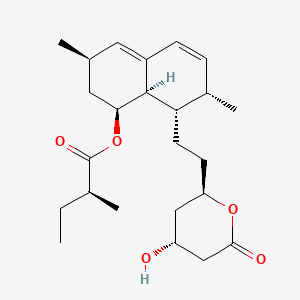"Cetirizine is used to temporarily relieve the symptoms of hay fever (allergy to pollen, dust, or other substances in the air) and allergy to other substances (such as dust mites, animal dander, cockroaches, and molds). These symptoms include sneezing; runny nose; itchy, red, watery eyes; and itchy nose or throat. Cetirizine is also used to treat itching and redness caused by hives. However, cetirizine does not prevent hives or other allergic skin reactions. Cetirizine is in a class of medications called antihistamines; It works by blocking the action of histamine, a substance in the body that causes allergic symptoms". (Medlineplus)
Histamine
The synthesis of Cetirizine is shown below. It includes five steps, 1) first the starting material 4-chlorobenzophenone is reduced to an alcohol with sodium borohydrate. 2)Then the alcohol form is converted to its acid chloride form by reaction with thionyl chloride. 3) The acid chloride is converted into an amine by reacting it with 2-piperazine-1-ylethanol in toluene solvent at 80oC, which gave a new primary alcohol group to the molecule (ethanol). 4) The ethanol part of the molecule was then reacted with 2-chloroacetamide in toluene and NaOMe at 85oC, which gave an ester/amide. 5) then the amide was hydrolyzed with sodium hydroxide to give a carboxylic acid.
And it's worth mentioning that all of the steps for the reaction were covered in the Organic Chemistry I and II courses.
Reagent Availability
4-chlorobenzophenone: Commercially available: 100 g - 31.20
4-chloroacetamide: Commercially available: 100 g - $25.30
1-(2-Hydroxyethyl)piperazine: Commercially available: 100 g - $29.90
Sodium Methoxyde: Commercially available: 100 g - $37.30
The general mechanism followed by the first step of the synthesis of Cetirizine, which is a reduction of a ketone to a secondary alcohol with the reducing agent sodium borohydryde is shown below. on this mechanistic scheme a proton from the nucleophile borohydryde attacksthe carbonyl group, causing the sp2 carbon to go to an sp3 hybridization. Therefore, giving an alcohol as the product.
Names of the authors of the article "New Manufacturing Process of Cetirizine"
a EGIS Pharmaceuticals Plc., †Chemical Research Division, and ‡Small Scale API Production Plant. Publication Date (Web): June 1, 2012
References
U.S National Library of Medicine, MedlinePlus, Cetirizine. http://www.nlm.nih.gov/medlineplus/druginfo/meds/a698026.html. Online. 27 March 2014. Accessed 04/19.2014.
Sharpley, Patricia, Borohydryde Reduction, University of Illinois; 2012. http://butane.chem.uiuc.edu/pshapley/GenChem2/B8/2.html. Online. accessed 4/19/2014.
.gif)
.gif)






.png)


